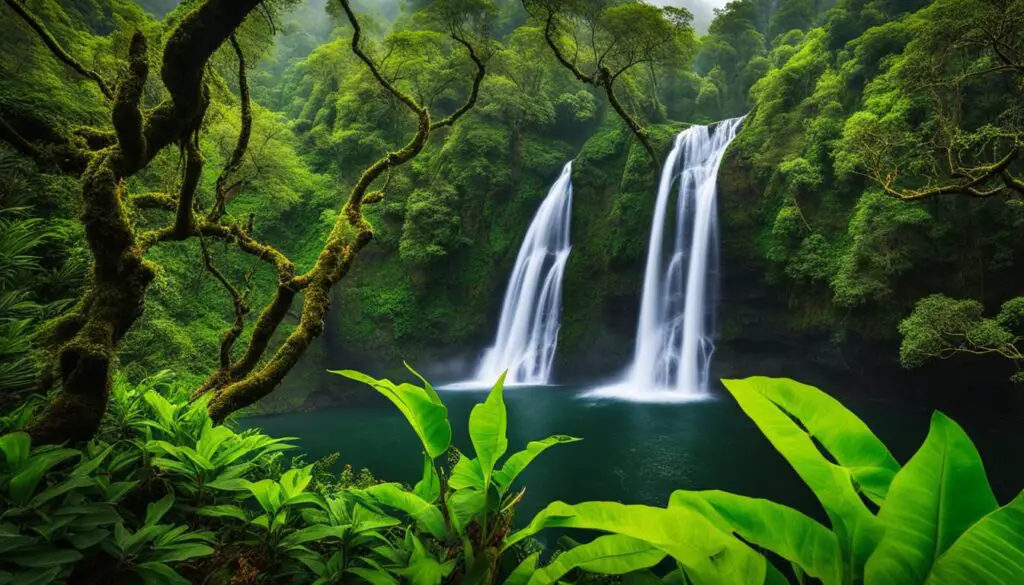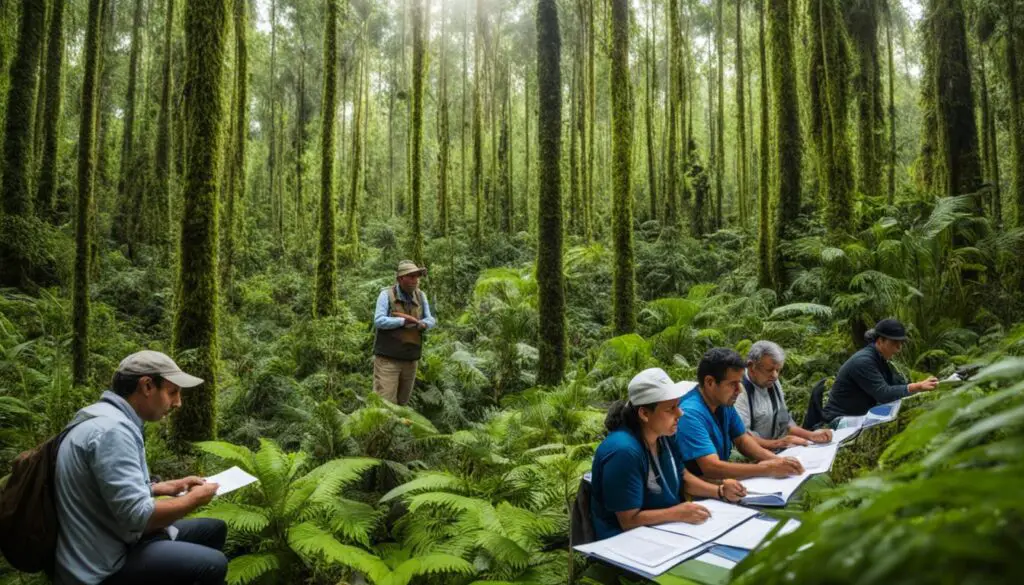The Gadgil Committee report on the Western Ghats is a significant ecological tract that examines the intersection of ecology and policy in India. Submitted to the Ministry of Environment and Forests in August 2011, this report proposes measures to conserve the Western Ghats—an ecologically fragile and diverse region.
The committee recommended designating the entire hill range as an Ecologically Sensitive Area (ESA) and advocated for a bottom-up approach to governance, involving local communities and decentralizing power. However, the report faced criticisms for being perceived as more environment-friendly than practical to implement.
Key Takeaways:
- The Gadgil Committee report focuses on conserving the Western Ghats, an ecologically sensitive region in India.
- It recommends designating the entire hill range as an Ecologically Sensitive Area (ESA).
- The report emphasizes a bottom-up approach to governance and decentralization of power.
- Criticisms have been raised regarding the practicality of implementing the committee’s recommendations.
- The report has sparked discussions on the balance between environmental conservation and development in India.
The Western Ghats: Importance and Challenges
The Western Ghats is an extensive region spanning six states, 44 districts, and 142 taluks in India. It is recognized as one of the world’s eight most important biodiversity hotspots and is home to numerous endangered plants and animals. The region plays a crucial role in supplying water to six states and supports the livelihoods of local communities.
However, the Western Ghats face various challenges, including human interference, pollution, and the depletion of natural resources. These challenges threaten the delicate balance of the ecosystem and the sustainability of the region. Environmental protection and conservation efforts are crucial to ensure the long-term survival of the Western Ghats and its unique biodiversity.

Conserving Biodiversity
The Western Ghats is home to a vast array of plant and animal species found nowhere else on Earth. It harbors over 7,400 species of flowering plants, 139 mammal species, 508 bird species, 179 amphibian species, and more. Protecting this rich biodiversity is essential not only for its intrinsic value but also for the ecosystem services it provides.
The Western Ghats is one of the most important biodiversity hotspots in the world, and its conservation should be a top priority. We must strive to protect and sustainably manage this invaluable natural resource for future generations.” – Dr. Kanika Sharma, Environmental Scientist
Sustainable Development
In order to address the challenges faced by the Western Ghats, it is imperative to adopt a sustainable development approach. This involves careful planning and management of land use, agriculture, infrastructure development, and tourism activities to minimize negative impacts on the environment while meeting the socio-economic needs of the local communities.
The Gadgil Committee report highlighted the importance of sustainable development and called for a bottom-up approach to governance and decentralization of power. It emphasized the need for a balance between economic growth and environmental protection, ensuring the long-term well-being of both people and nature.
Preserving Water Resources
The Western Ghats act as a crucial watershed, providing water to six states in India. The rivers originating from the Ghats supply drinking water, irrigation, and hydropower to millions of people. Protecting the forests, wetlands, and rivers in the Western Ghats is essential to maintain the flow of water and ensure its quality.
Efforts to conserve the Western Ghats must focus on protecting its water resources through sustainable water management practices, afforestation, and the prevention of pollution and encroachments. Strong environmental policies and active community participation are key to preserving the water sources that sustain life in the region.
The Gadgil Committee Report: Recommendations and Controversies
The Gadgil Committee report, also known as the Western Ghats Ecology Expert Panel (WGEEP) report, recommended declaring the entire Western Ghats as an Ecologically Sensitive Area (ESA). The report classified the 142 taluks in the Western Ghats boundary into Ecologically Sensitive Zones (ESZ) 1, 2, and 3, with ESZ-1 being of high priority. The committee proposed restrictions on developmental activities, such as mining and thermal power plants, in ESZ-1. The report also called for a change in the governance system, with more power given to local authorities and the constitution of a Western Ghats Ecology Authority (WGEA).
However, the report faced criticism for being too environment-friendly and not considering the ground realities and the livelihood issues of the local communities. Critics argued that the proposed restrictions would hinder development and economic growth, affecting the livelihoods of people dependent on industries in the region. The controversy surrounding the Gadgil Committee report led to further debates and discussions on finding a balance between environmental conservation and sustainable development in the Western Ghats.
“The Gadgil Committee report’s focus on ecological sensitivity is commendable, but its implementation challenges cannot be ignored. The livelihood issues of the local communities must be taken into consideration to find the right balance.” – Environmental Expert
Ecologically Sensitive Zones in the Western Ghats
| Ecologically Sensitive Zone | Description |
|---|---|
| ESZ-1 | High priority zone with stringent restrictions on developmental activities. |
| ESZ-2 | Moderate priority zone with controlled and regulated development. |
| ESZ-3 | Low priority zone with flexible regulations, allowing for sustainable development. |
The controversy surrounding the Gadgil Committee report led to the formation of the Kasturirangan Committee, which reviewed the recommendations and proposed a more lenient approach. The Kasturirangan Committee report aimed to strike a balance between environmental conservation and development by introducing zonal regulations. These regulations categorized areas as per their ecological significance and recommended specific activities for each zone.
The debates and controversies surrounding the Gadgil Committee report and the subsequent discussions have highlighted the complexities involved in balancing environmental protection and socio-economic development. It is essential to involve all stakeholders, including local communities, industries, and policymakers, in finding sustainable solutions to preserve the ecologically sensitive Western Ghats for the benefit of future generations.

Conclusion
The Gadgil Committee report on the Western Ghats has been instrumental in shaping India’s ecological policy and environmental protection efforts. By igniting debates and discussions, the report has brought attention to the delicate balance between environmental conservation and development. It has emphasized the urgency of adopting sustainable practices to ensure the long-term well-being of the Western Ghats and its diverse ecosystem.
While the Gadgil Committee report faced criticism and controversies for its recommendations and implementation challenges, it prompted the appointment of the Kasturirangan Committee to review and suggest measures for implementation. The simultaneous contribution of these committees has been invaluable in advancing the ongoing dialogue on how best to safeguard and preserve the Western Ghats’ irreplaceable ecological resources.
As India continues to grapple with the complexities of environmental policy, the Gadgil and Kasturirangan Committee reports serve as milestones in charting a sustainable course for the Western Ghats. It is crucial that future conservation efforts take into account the diverse perspectives and interests of stakeholders, including local communities and experts.
To effectively protect the Western Ghats, a well-balanced approach that integrates environmental concerns with developmental needs is essential. By learning from the insights and recommendations of the Gadgil and Kasturirangan Committee reports, India can work towards creating a comprehensive and inclusive environmental policy framework that ensures the longevity of this unique and precious ecological treasure.
FAQ
What is the Gadgil Committee report?
The Gadgil Committee report, also known as the Western Ghats Ecology Expert Panel (WGEEP) report, is a major ecological tract that explores the politics of ecology and the implications of different approaches to reading ecology. It was submitted to the Ministry of Environment and Forests in August 2011 and recommended measures for conserving the Western Ghats.
What did the Gadgil Committee recommend?
The Gadgil Committee recommended designating the entire Western Ghats as an Ecologically Sensitive Area (ESA). It classified the 142 taluks in the Western Ghats boundary into Ecologically Sensitive Zones (ESZ) 1, 2, and 3, with ESZ-1 being of high priority. The committee proposed restrictions on developmental activities in ESZ-1 and called for a change in the governance system.
What challenges does the Western Ghats face?
The Western Ghats face various challenges, including human interference, pollution, and the depletion of natural resources. These challenges threaten the biodiversity and ecological integrity of the region.
Why was the Gadgil Committee report criticized?
The report faced criticism for being too environment-friendly and not considering the ground realities and the livelihood issues of the local communities. It was also criticized for being impractical to implement.
What is the significance of the Gadgil Committee report?
The Gadgil Committee report played a significant role in shaping India’s ecological policy and environmental protection efforts. It sparked debates and discussions about the balance between environment and development and highlighted the need for sustainable practices.
How does the Gadgil Committee report relate to the Kasturirangan Committee report?
The Gadgil Committee report and the subsequent Kasturirangan Committee report both contribute to the ongoing dialogue on how to protect and preserve the invaluable ecological resources of the Western Ghats for future generations. While there are differing opinions and perspectives on these reports, they have shaped India’s environmental policy and conservation efforts.
